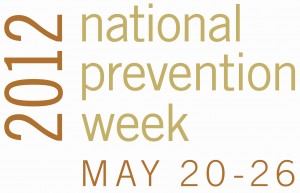Take Action during National Prevention Week – Prevent the Loss of Even One Life
 Written By: Frances M. Harding, Director, Center for Substance Abuse Prevention
Written By: Frances M. Harding, Director, Center for Substance Abuse Prevention
Suicide is devastating to family, friends, and communities. SAMHSA estimates that for each person that dies by suicide, 5 to 10 other people are severely affected by the loss.1 Each year, suicide accounts for more than 37,000 deaths in the United States, meaning hundreds of thousands of people are touched by this issue.2
People of all ages die by suicide, but youth are specifically at risk. Suicide is the third leading cause of death for 15 to 24 year olds.3 Gay, lesbian, and bisexual adolescents in grades 7 through 12 are more than twice as likely to attempt suicide as heterosexuals within the same age range.4
As we continue to celebrate National Prevention Week, it’s important to highlight the critical need for suicide prevention efforts. Suicide prevention is complex and can involve addressing mental health concerns such as depression, alcohol and/or drug abuse, along with other life stresses. Suicide prevention includes reducing risk factors and strengthening resilience and other protective factors such as: 1) connectedness with individuals, family, community, and social institutions, 2) coping abilities, 3) effective physical and mental health care, and 4) problem solving skills.
Help someone who is in crisis, and may be considering suicide by taking one or more of the following steps, which can be found at SAMHSA’s National Suicide Prevention Lifeline Web page :
- Allow the person to express his or her feelings without passing judgment or acting shocked.
- Listen, and don’t debate whether suicide is right or wrong.
- Be direct and get involved. Talk openly and matter-of-factly, showing interest and support for the person at risk.
- Don’t be sworn to secrecy – seek support and professional help for the person at risk.
- Offer hope that alternatives are available.
- Get help from people or agencies that specialize in crisis intervention and suicide prevention.
SAMHSA’s What a Difference a Friend Makes campaign provides additional guidance and encourages, educates, and inspires people between the ages of 18 and 25 to support their friends who are experiencing mental health problems. Also, since its 2010 YouTube debut, the It Gets Better project has become a worldwide movement in suicide prevention among LGBT youth, inspiring more than 40,000 user-created videos that have been viewed more than 40 million times. These types of initiatives show how simple acts, like showing acceptance and support, can make a big difference in suicide prevention.
If you are concerned that you or someone you love may be considering suicide, confidential help is available 24 hours a day through the National Suicide Prevention Lifeline at 1-800-273-TALK (8255), a toll-free service funded by SAMHSA.
Take action to raise awareness about suicide prevention in your community and social circles . Utilize and refer others to available resources, because the loss of even one life to suicide is one too many.
Visit the National Prevention Week Web site to learn more about this new health observance and SAMHSA-supported resources and programs focused on prevention. Take and share the “Prevention Pledge” on SAMHSA’s Facebook page to commit to a healthy lifestyle year-round and get others involved!
———————————————————————-
Sources:
- Substance Abuse and Mental Health Services Administration (SAMHSA). (2006). CSAP’s Prevention Pathways: Holding the Lifeline, a Guide to Suicide Prevention. Retrieved December 20, 2011, from http://pathwayscourses.samhsa.gov/suicide/suicide_supps_pg9.htm.
- Centers for Disease Control and Prevention (CDC). (2011). Deaths: Preliminary Data for 2010. (National Vital Statistics Report, Vol. 60, No. 4: January 11, 2012). Retrieved January 12, 2011, from http://www.cdc.gov/nchs/data/nvsr/nvsr60/nvsr60_04.pdf
- /4 Centers for Disease Control and Prevention (CDC). (2007). Web-based Injury Statistics Query and Reporting System (WISQARS) (Online). Retrieved December 20, 2011, from http://www.cdc.gov/injury/wisqars/index.html. As cited in Substance Abuse and Mental Health Services Administration (SAMHSA). (2011). Leading Change: A Plan for SAMHSA’s Roles and Actions 2011-2014. (HHS Publication No. SMA 11-4629). Rockville, MD.

